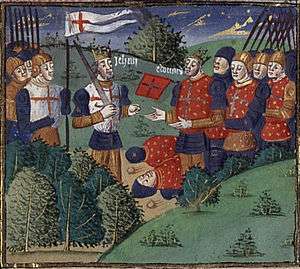Black Prince's chevauchée of 1356
The Black Prince's chevauchée of 1356, which began on 4 August at Bordeaux and ended with the Battle of Poitiers on 19 September, was a devastating raid of Edward of Woodstock, Prince of Wales (known as the Black Prince), the eldest son of King Edward III of England. This expedition of the Black Prince devastated large parts of Bergerac, Périgord, Nontronnais, Confolentais, Nord-Ouest, Limousin, La Marche, Boischaut, Champagne Berrichonne, Berry, Sologne, south of Touraine and Poitou.
Background
In the spring of 1356, the Black Prince assembled at La Réole, a force of about 9,000 men. The French deduced that the Prince of Wales was preparing to repeat his chevauchée of the autumn of 1355. King John II of France, then at the siege of Breteuil in Normandy, sent reinforcements to reinforce the army of the Dauphin Charles, positioned at Bourges, to support the possessions and cities of Languedoc.
Aftermath
The chevauchée of the Black Prince in 1356 was very successful for the English. The defeat of the French army at Poitiers was more humiliating for the French than that of Crécy in 1346. At Poitiers and Crécy, the French used identical strategies, which resulted in identical failures. In 10 years, the French had not evolved their military technique. With the capture of John II, this led to a lengthy period of instability within France.
References
- Herbert J. Hewitt, The Black Prince’s Expedition of 1355-1357, Manchester, Manchester University Press, 1958.
- Clifford J. Rogers, War Cruel and Sharp: English Strategy Under Edward III, 1327-1360
